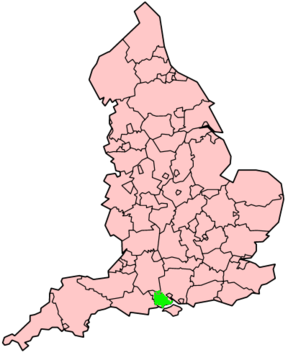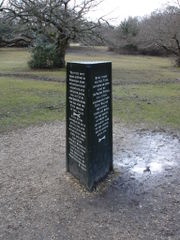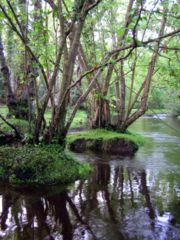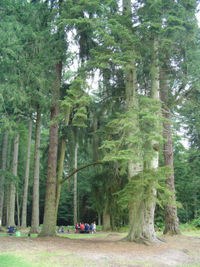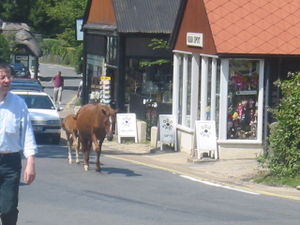New Forest
2007 Schools Wikipedia Selection. Related subjects: Geography of Great Britain
| New Forest National Park | |
|---|---|
| IUCN Category V (Protected Landscape/Seascape) | |
|
|
|
| Location: | Hampshire, United Kingdom |
| Nearest city: | Southampton |
| Coordinates: | |
| Area: | 571 km² (141,097 acres) |
| Established: | 1079 |
| Visitation: | 7.5 Million (in 1992) |
| Governing body: | New Forest National Park Authority |
The New Forest is an area of southern England which includes the largest remaining tracts of unenclosed pasture land, heathland and old-growth forest in the heavily-populated south east of England. The contiguous New Forest habitat covers south west Hampshire and some of south Wiltshire and east Dorset. As a National Park the New Forest is mainly in Hampshire, but also covering some of Wiltshire. Additionally the New Forest local government district is a subdivision of Hampshire which covers most of the forest, and some nearby areas. There are many small villages dotted arond the area
The highest point in the New Forest is Piper's Wait, just west of Bramshaw. Its summit is at over four hundred feet.
History
Like much of England, the New Forest was originally forested, but parts were cleared for cultivation from the Stone Age and into the Bronze Age. However, the poor quality of the soil in the new forest meant that the cleared areas turned into heathland "waste". There are around 250 round barrows within its boundaries, and scattered boiling mounds, and it also includes about 150 scheduled ancient monuments.
The New Forest was created as a royal forest in 1079 by William the Conqueror for the hunting of (mainly) deer. It was first recorded as "Nova Foresta" in the Domesday Book in 1086. The inhabitants of thirty-six parishes were evicted. William's successor, William Rufus was killed in a suspicious accident while hunting in the New Forest in 1100. The reputed spot of the king's death is marked with a stone known as the Rufus Stone.
As of 2005, roughly 90% of the New Forest is still owned by the Crown. The Crown lands have been managed by the Forestry Commission since 1923. Around 50% of the Crown lands fall inside the new National Park.
Formal commons rights were established in the 16th century. Over time, the New Forest became an important source of wood for the Royal Navy, and plantations were begun to replace the felled trees. In the Great Storm of 1703, about 4,000 oak trees were lost in the New Forest.
The naval plantations encroached on the rights of the Commoners, but the Forest gained new protection under an Act of Parliament in 1877. The New Forest Act 1877 confirmed the historic rights of the Commoners and prohibited the enclosure of more than 16,000 acres (61 km²) at any time. It also reconstituted the Court of Verderers as representatives of the Commoners (rather than the Crown).
Felling of broadleaf trees, and replacement by conifers, began during the First World War to meet the wartime demand for wood. Further encroachments were made in the Second World War. This process is today being reversed in places, with some plantations being returned to heathland or broadleaf woodland.
Further New Forest Acts followed in 1949, 1964 and 1970. The New Forest became a Site of Special Scientific Interest in 1971, and was granted special status as the "New Forest Heritage Area" in 1985, with additional planning controls added in 1992. The New Forest was proposed as a UNESCO World Heritage Site in June 1999, and it became a National Park in 2005.
Common rights
Forest Laws were enacted to preserve the New Forest as a location for royal deer hunting, and interference with the King's deer and its forage was severely punished. Over time, the local inhabitants ("Commoners") were granted or took on various "rights of common": to turn ponies, cattle and donkeys (and formerly sheep) out into the Forest to graze ("common pasture"), to gather wood (" estovers"), to gather bracken after 29 September as litter for animals ("fern"), to cut peat for fuel (" turbary"), to dig clay (" marl"), and to turn out pigs between September and November to eat fallen acorns and beechnuts (" pannage" or "mast"). Along with grazing, pannage is still an important part of the forest ecology. Pigs can eat acorns without a problem, whereas to ponies the acorns are poisonous. Pannage always lasts 60 days but the start date varies according to the weather - and when the acorns fall. The Verderers decide when pannage will start each year. At other times the pigs must be taken in and kept on the owner's land, with the exception that pregnant sows, known as "privileged sows" are always allowed out providing they return to the Commoner's holding at night, and are not a nuisance. This is not a true Right, it is an established practice.
Geography
The New Forest Heritage Area covers about 580 km² (143321 acres), and the New Forest SSSI covers almost 300 km² (74131 acres), making it the largest contiguous area of un-sown vegetation in lowland Britain. It includes roughly:
- 146 km² (36077 acres) of broadleaf woodland
- 118 km² (29158 acres) of heathland and grassland
- 33 km² (8154 acres) of wet heathland
- 84 km² (20756 acres) of tree plantations ("inclosures") established since the 18th century, including 80 km² (19768 acres) planted by the Forestry Commission since the 1920s.
It is drained to the south by two rivers, the Lymington and Beaulieu.
Wildlife
As well as providing a visually remarkable and historic landscape, the ecological value of the New Forest is particularly great because of the relatively large areas of lowland habitats, lost elsewhere, which have survived. The area contains several kinds of important lowland habitat including valley bogs, wet heaths, dry heaths and deciduous woodland. The area contains a profusion of rare wildlife, including the New Forest cicada, the only cicada native to Great Britain. The wet heaths are important for rare plants, such as marsh gentian Gentiana pneumonanthe and marsh clubmoss Lycopodiella inundata. Several species of sundew may be found in the Forest, and the area is also the habitat of many unusual insect species, including the Southern damselfly, and the great crested newt breeds in many locations.
Three species of snake inhabit the Forest. The adder is the most common being found on open heath and grassland. The grass snake prefers the damper environment of the valley mires. The rare smooth snake can be found on sandy hillsides with heather and gorse.
A program to reintroduce the sand lizard started in 1989.
Numerous deer live in the Forest but are usually rather shy and tend to stay out of sight when people are around. Fallow deer are the most common followed by red deer. There are also smaller populations of sika deer and Muntjac.
The New Forest is designated as an EU Special Area of Conservation.
Settlements
Among the towns and villages lying in or adjacent to the Forest are Lyndhurst (which claims to be the 'capital' of the New Forest), Brockenhurst, Fordingbridge, Ringwood, Beaulieu, Bransgore and Lymington. It is bounded to the west by Bournemouth and to the east by the city of Southampton. The forest gives its name to the New Forest district of Hampshire.
See also List of locations in the New Forest
New Forest National Park
Consultations on the possible designation of a National Park in the New Forest were commenced by the Countryside Agency in 1999. An order to create the park was made by the Agency on 24 January 2002 and submitted to the Secretary of State for confirmation in February 2002. Following objections from seven local authorities and others, a Public Inquiry was held from 8 October 2002 to 10 April 2003, concluding with that the proposal should be endorsed with some detailed changes to the boundary of the area to be designated.
On 28 June 2004, Rural Affairs Minister Alun Michael confirmed the government's intention to designate the area as a National Park, with further detailed boundary adjustments. The area was formally designated as such on 1 March 2005. A National Park Authority for the New Forest was established on 1 April 2005 and assumed its full statutory powers on 1 April 2006. The Forestry Commission retain their powers to manage the Crown land within the Park, and the Verderers under the New Forest Acts also retain their responsibilities, and the Park Authority is expected to co-operate with these bodies, the local authorities, English Nature and other interested parties.
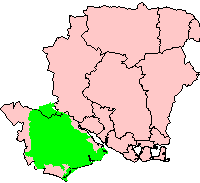
The designated area of the National Park covers 571km² (141097 acres) and includes many existing SSSIs. It has a population of approximately 38,000 (excluding most of the 170,256 people who live in the New Forest local government district). As well as most of the New Forest district of Hampshire, it takes in a small corner of Test Valley district around the village of Canada, and part of the Salisbury district in Wiltshire south-east of Redlynch.
However, the area covered by the park does not include all the areas which were initially proposed; excluding most of the valley of the River Avon to the west of the forest and Dibden Bay to the east. Two challenges were made to the designation order, by Meyrick Estate Management Ltd in relation to the inclusion of Hinton Admiral Park, and by RWE NPower Plc to the inclusion of Fawley power station. The second challenge was settled out of court, with the power station being excluded. The High Court upheld the first challenge; as of April 2006, it is expected that an appeal against the decision will be heard by the Court of Appeal in Autumn 2006.
Visitor Attractions and Places
- Buckler's Hard
- Beaulieu
- New Forest Show
